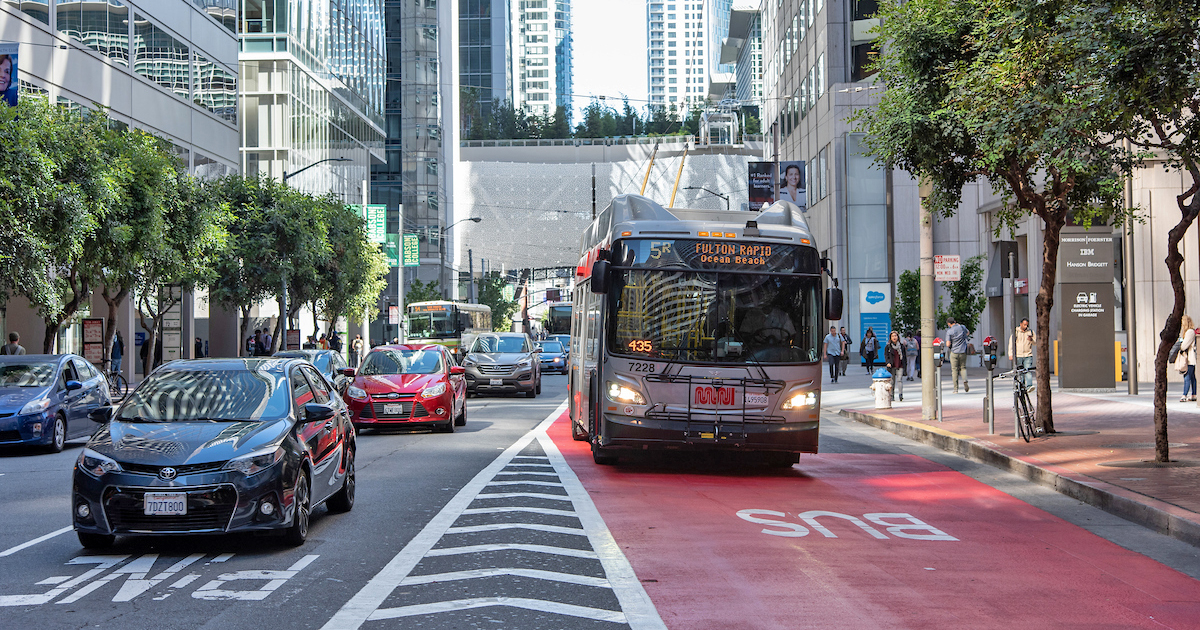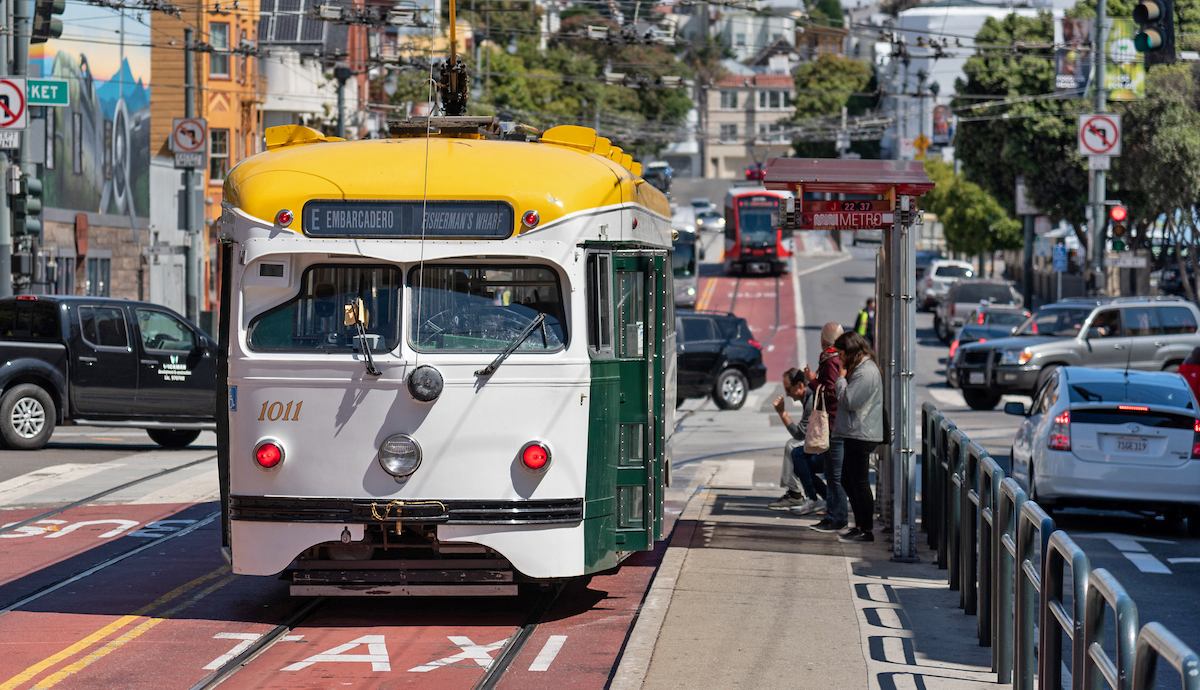By Amy Fowler

San Francisco’s transit lanes are nothing new, but you may have seen more of them lately. They’ve been a part of the city’s transit system for over 40 years, and today San Francisco has more than 43 miles of these dedicated transit lanes, which are critical to helping Muni move our growing population. Since Muni began painting them red in 2013, they’ve become even more visible throughout the city.
Just got a transit lane in your neighborhood or Muni line? We’ve got the scoop on what you need to know.
What are transit lanes?
Transit lanes are lanes that are dedicated to Muni vehicles and other buses. Taxis are also allowed to use most transit lanes, but not app-based rail hail services such as Lyft and Uber. Along with other Muni Forward improvements, transit lanes help improve travel time and reliability on Muni buses and trains and protect transit riders from growing traffic congestion.
Transit lanes benefit people who ride and drive. Over 700,000 people ride the bus every day in San Francisco. Buses reduce traffic and air pollution because they are more space and fuel-efficient than driving. Transit lanes keep buses from getting stuck in traffic, and when more people choose transit because it’s fast and reliable, there are fewer cars on the street. That means less congestion for people who do drive.
What are the benefits of colorizing transit lanes red?
Not all transit lanes are red, but colorizing these lanes yields even greater benefits to transit riders. In general, painting these lanes red has led to about a 50% reduction in drivers violating transit lanes.
Red colorization also makes it easier for drivers to know where they’re allowed to drive. By making transit lanes extra clear, you’re less likely to get a citation for unintentionally driving in a transit lane.
San Francisco is a leader in using red transit lanes to give buses and trains priority on the street. Following San Francisco’s success, many cities are now using this approach, including New York, Washington, DC, Portland, Seattle, Boston, and more.
How do we implement red transit lanes?
Red transit lanes are installed by SFMTA crews, just like other roadway markings. We use a special highly durable material for the lanes called thermoplastic to increase their longevity.
How do we evaluate red transit lanes?
Since 2013, the SFMTA has been participating in a national experiment with the Federal Highway Administration (FHWA) regarding the use of red color to reinforce compliance with transit lanes. Each new red transit lane is first installed as a standard transit lane without red paint for several months. During that time, “before” data on transit travel time, safety, and compliance is collected. After the lane is upgraded with red paint, “after” data is also collected. This data will help San Francisco and other cities learn more about the benefits of red transit lanes.
Where are San Francisco’s newest transit lanes?
In late 2018, transit lanes without red colorization were installed on Geary Boulevard from Stanyan to Gough streets and bus stop changes were made as part of the Geary Rapid Project. Riders on the 38R Geary Rapid are already feeling the difference with trips that are up to 20% faster. Staff collected the “before” data earlier this year and towards the end of the project, after other improvements such as utility upgrades and repaving are complete, we will install the red lane treatment.
Earlier this year, the SFMTA Board of Directors approved improvements to both 3rd and 4th streets in SoMa as part of Muni Forward’s system-wide approach to transit-priority improvements. These two streets serve some of Muni’s busiest bus lines, including the 30 Stockton, 45 Union-Stockton, 8 Bayshore, and the 8AX and 8BX Bayshore Expresses. We’re expecting up to a 20% time savings in total. As part of the 3rd Street Transit and Safety Project, construction is underway on 3rd Street between Townsend and Market to relocate the existing red transit lane to reduce conflicts with cars. In October, the 4th Street Transit Improvement Project was approved to create a full time, red transit lane on 4th Street between Market and Folsom and the lane will be added in early 2020. Following the collection of “before” data, the 4th Street lane will be painted red.
Other transit lane projects are also collecting “before” data, and we have plans to install additional red transit lanes in the coming months in corridors with existing non-red transit lanes such as lower Stockton Street. Market Street’s existing red transit lanes will also be extended in early 2020 as part of the Better Market Street project.
Rules of the road: When can cars or bicycles enter transit lanes?
Drivers and cyclists can still legally enter transit lanes to make turns into businesses or to turn left or right at most intersections. It is also okay to enter a transit lane to pull into or out of a parking space next to the lane. However, just like any active traffic lane, pick-ups, drop-offs and double parking are not allowed in transit lanes.
How are the lanes enforced?
SFPD patrols transit lanes for moving and parking violations, and double parking in transit lanes is enforced by SFMTA’s parking control officers and by cameras on Muni buses. If you’re not actively parking or preparing to make a turn, it’s best to stay out of transit lanes.
Published November 26, 2019 at 11:49PM
https://ift.tt/33spACJ

Comments
Post a Comment